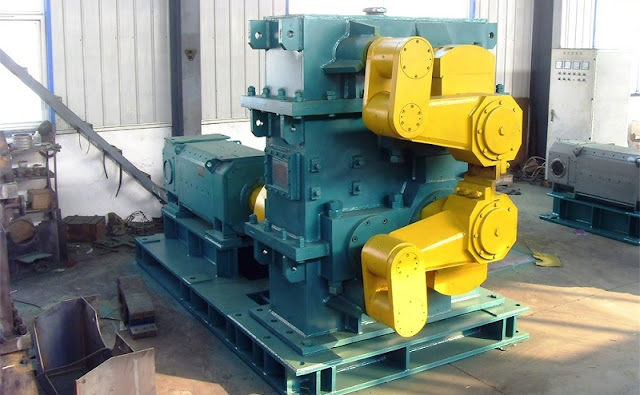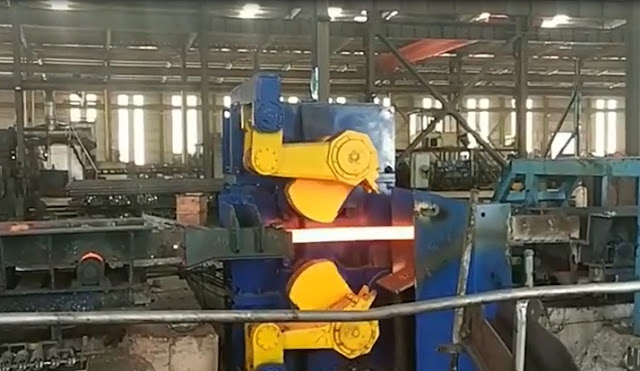Flying Shear in Rolling Mill
Application and Classification of Flying Shear
The flying shears used to shear the rolling pieces in transverse motion are called rolling mill flying shears. With the development of continuous plate mill, section mill, and billet mill and the improvement of flying shear productivity, the application of flying shear is more and more widely. There are many types of flying shears, such as disc flying shears, double drum flying shears, crank rotary flying shears, and pendulum flying shears.
1. Disc Flying Shear
This kind of flying shear is generally used in the small rolling locomotive room. It is installed in front of the cooling bed to roughly cut the rolled piece, so that the rolled piece entering the cooling bed is not too long; Or it can be installed before the finishing mill to cut the ends of the rolled piece to ensure the smooth-rolling process of the finishing mill. The flying shear consists of two or more pairs of disc-shaped blades. The axis of the disc is equal to the movement speed of the steel. When the flying shear is in the original position, the steel will advance along the inlet duct to the left of the flying shear. When the steel acts on the flag switch or the light guide tube, the inlet tube and the steel incline to the right, and the steel go into the middle of the two discs for shearing. After the lower blade descends, the guide pipe makes the steel return to the original left position, and then the lower blade rises again. The disadvantage of this kind of flying shear is that the cut is inclined, but it has little effect on the cutting or rough cutting of rolled piece before the cooling bed. Because of its reliable operation, simple structure, and shearing speed of more than 10 m / s, it has been widely used in small rolling locomotives.
2. Double Drum Flying Shear
The double drum flying shear is widely used to cut the section steel and steel plate in motion. Its working principle is as follows: two blades are fixed radially on two rotating drums. The rolled piece moving along the roller table is sheared by two blades when passing between two rollers. The circular speed of the blade should be slightly greater than the moving speed of the rolled piece, otherwise, the rolled piece will be bent at the entrance during shearing. The disadvantage of this kind of flying shear is that the section is not smooth when cutting thick rolled pieces (it has too much influence on cutting thin rolled pieces); When the wide steel plate is sheared, the shear force is larger. Therefore, this kind of flying shear is used to shear small section steel and thin plate of high-speed rolling piece.
3. Crank Rotary Flying Shear
Its shearing mechanism is composed of four-bar linkage. The cutting edge moves approximately in-plane in the shearing area and is perpendicular to the surface of the rolled piece. Therefore, the cross-section of the rolled piece is relatively straight. The cutting mechanism of flying shear is composed of tool holder, eccentric sleeve and swing bar. One end of the tool holder is fixed on the eccentric sleeve, and the other end is connected with the swing rod. The swing fulcrum of the swing rod is hinged on the column. When the eccentric sleeve (crank) rotates, the tool holder moves in translation, and the blade fixed on the tool holder can be vertical or nearly vertical to the rolled piece. In order to reduce the shear force, the inclined blade can be used to shear the steel plate. The disadvantage of this kind of flying shear is that the structure is complex, the dynamic load characteristic of the cutting mechanism is poor, and the moving speed of the blade can not be too fast. It is generally used to shear thick steel plate or billet.
4. Swing Flying Shear
This kind of flying shear is sometimes used in the cross-cutting unit of continuous steel plate rolling locomotive. The blade of the flying shear also moves in translation, and the quality of the cutting plate is better. The upper tool rest is fixed on the swing frame. The swing frame is supported by the eccentricity of the spindle. There are two pairs of eccentricities on the spindle. The other pair of eccentricities is connected with the lower tool rest through the connecting rod. The lower tool rest can slide in the chute of the swing frame. Because the two pairs of eccentric positions on the spindle are 180 different °, Therefore, when the spindle rotates, the upper carriage will descend with the frame, while the lower carriage will rise to complete the shearing action. However, it can only shear the static rolled piece. In order to shear the moving workpiece, it is necessary to make the swing frame swing back and forth. The lower part of the swing frame is hinged with an eccentric rod, and the eccentric wheel is installed on the rear axle. The rear axle is connected with the main shaft through the pinion, rack, and synchronous disc. When the main shaft rotates, the rack can swing back and forth with the main shaft as the center through the synchronous disc, rack, pinion, and eccentric connecting rod on the rear shaft. At this time, the tool holder moves in translation to realize the shearing work of the pendulum flying shear. The function of shear in the rolling mill is not the key position, but it plays an important role in the precision and shape of the finished product. Different types of the rolling mills should choose the corresponding flying shear so that the whole production line can achieve the target size and precision.
Free send inquiry to stella@hanrm.com if any needs.
Whatsapp/Wechat:+8615877652925
Website: https://www.hanrm.com
More News You May Interesting:
Why does the Steel Bar Bend after being Cut by Flying Shear?
Finishing Rolling Mill Process Explanation
Reasons and Solutions for the Piling of Wire Rod Rolling
Characteristics and Quality of Wire Rod
Morgan Wire Rod Mill
Headless Welding Rolling Process
Bar Rolling Mills Water Cooling Technology
How to Improve the Thermal Efficiency of the Reheating Furnaces?
Causes of Surface Cracks in High-Speed Wire Rod Rolling Mill
What is Slit Rolling?
Failure Analysis of Cold Mill Roll
Causes and Solution of Steel Piling-up in High-speed Wire Rod Rolling Mills?
Bar Automatic Counting System
Rolling Mill Pass Design























